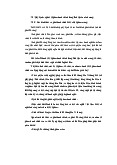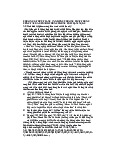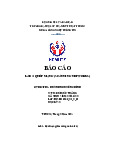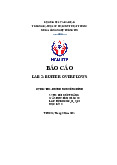






Preview text:
Fall 2019 Chris Christensen MAT/CSC 483 Section 7 Playfair Cryptanalysis
Because the Playfair cipher encrypts digraphs – two-letter blocks – plaintext
frequencies are spread over 676 digraphs rather than 26 single letters. The
frequency distribution will tend to be more uniform.
Here is a frequency chart for digraphs.
Although there are high frequency digraphs – for example th – and low
frequency digraphs – for example z ,
b the peaks and valleys are not as
profound as for single letters. Notice that the frequency distribution is flatter.
Trigraphs have even flatter frequencies. Quadgraphs flatter still. Etc. Most
symmetric key block ciphers in use today encrypt strings of 16 letters at one time. 1
Known Plaintext Attack on a Playfair Cipher
Here is a ciphertext message that was enciphered with a Playfair cipher.
BPLYK RLHFE KIDBN FVUVI VZHZO PKERV NDFVL
XWFES FEYSP TONLY NRBLE PHZSF TABQB NSEMB NZVAQ Z
Here are the ciphertext single-letter frequencies.
The single-letter frequencies are more uniform – flatter -- than we would expect for a MASC.
We will do a known plaintext attack. Recall that because the Playfair cipher
encrypts digraphs typically longer ciphertexts are needed to successfully cryptanalyze the message.
We suspect that the phrase “commander in chief fleet to naval headquarters”
begins the message. If so, the plaintext/ciphertext correspondence would be:
co mx ma nd er in ch ie fx fl ex et to na va lh ea dq ua rt
BP LY KR LH FE KI DB NF VU VI VZ HZ OP KE RV ND FV LX WF ES er s_
FE YS PT ON LY NR BL EP HZ SF TA BQ BN SE MB NZ VA QZ 2
This happens to be the correct placement of the plaintext, but there are a
couple of ways to match up plaintext and ciphertext for a message
enciphered with a Playfair cipher:
When using a Playfair cipher, no plaintext letter will be enciphered as
itself. That is the case with the correspondence above. (This also
happens with Enigma ciphers and was used by the British
codebreakers to do known plaintext attacks on Enigma messages.)
Reversed plaintext digraphs correspond to reversed ciphertext
digraphs; e.g, if er = DM, then re = M .
D There are no reversals in the plaintext given above. 3
Two other things to keep in mind when attacking a Playfair cipher:
A plaintext letter can only be enciphered as one of 5 other letters – the
letters in its row or the letter immediately below it. For example * * * letter * *
Of these 5 possibilities, a plaintext letter is twice as likely to be
enciphered as the letter immediately to the right of it in the Playfair
square. A letter will be enciphered as the letter immediately to its
right if the other letter in the digraph is in the same row as the given
letter or if the other letter in the digraph appears in the column
immediately to the right of the given letter.
We begin with the first pair of digraphs: co = BP; c goes to B and o goes
to P. Recall how the Playfair cipher enciphers messages. There are 3
possibilities; the following gives one example of each type. c B c c B o P or B or P o o P
Of course we do not know the number of columns between c and B in the
first case nor do we know that the arrangement is not 4 B c
, and we do not know the location of the 4 letters in o P
the column in case 2 nor the location of the 4 letters in the row in case 3.
As we proceed, it will be useful to select plaintext/ciphertext
correspondences that have letters in common with previous correspondences.
For example, let’s look at to = OP; t goes to O and o goes to P. This is an
interesting situation; this cannot be arranged in a rectangle. We must have t either something like O or . P t O P
When we try to merge one of these squares with one of the first squares, it c B seems that if the square is rearranged to P o 5 B c , it can be merged with . o P t O P
It’s likely that in both rows we are seeing alphabetical order. Because O is
to the right of t, it appears that t is the last entry in the row and O is the first B C entry.
. Between P and T there are spots for 2 letters – O P T
one of Q, R, S is in the keyword. Notice that et = H .
Z Let’s play a hunch that Z will occur in the bottom
right of the square. Then it would appear that in the last column we would have e H t Z E B C H So, probably . O P T Z
In the last row, there is space for 4 letters; between T and Z we would have
U, V, W, X, Y. One of these letters must be in the keyword. It also 6
appears that F is in the keyword. So, in the keyword is F, one of Q, R, S and one of U, V, W, X, Y.
Now notice that ea = FV. F should be in the first row. Because E is also, it appears that e, a, ,
F and V are all in the first row – in the keyword -- in
this order eFaV. The last row must be U, W, X, Y, Z. F must follow e; so, F
must be the first letter of the row, and a must follow F. So, the first
row is FAV_E or F_AVE. r must be in the first row and we must have FAVRE. F A V R E B C D G H The square is I J K L M N . O P Q S T U W X Y Z 7




